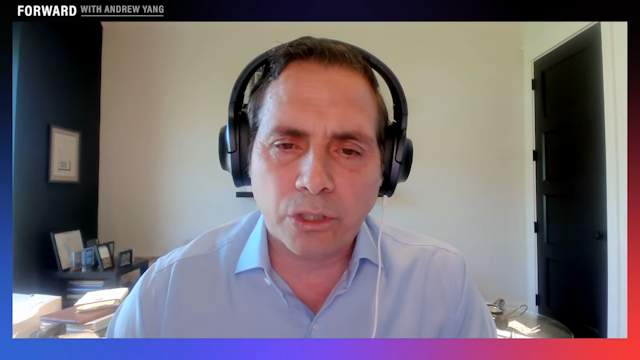Rand Paul on Tax Reform: Everybody Should Get a Tax Cut

Congress returns Tuesday from their August recess to a packed legislative session. Number one on the agenda for the White House and Republicans on Capitol Hill is the ambitious goal of putting together a comprehensive tax reform bill and sending it to President Trump by October.
The government will have to move forward on tax reform while managing several other legislative priorities, not the least of which is the federal debt ceiling, which the government will exceed by month's end. Technically the U.S. has already reached its borrowing limit, but the Treasury Department has taken various stop gap measures to buy some time.
The current debt limit is $19.8 trillion. For a point of comparison, the debt ceiling was $5.5 trillion twenty years ago in 1996. In today's dollars, that mid-1990s debt ceiling would still be "only" $12.7 trillion.
Leading up to this legislative session, Trump and "The Big Six" have heralded the move for tax reform this Fall, with the president speaking about his plan to a manufacturer in Springfield, Missouri and telling an audience of supporters that his plan will be "pro-growth, pro-jobs, pro-worker, and pro-American."
The Big Six
The "Big Six" are: House Speaker Paul Ryan (R-WI), House Ways and Means Chairman Kevin Brady (R-TX), Senate Majority Leader Mitch McConnell (R-KY), Senate Finance Committee Chairman Orrin Hatch (R-UT), White House National Economic Council (NEC) Director Gary Cohn, and Treasury Secretary Steven Mnuchin.
Trump's appearance in Springfield underscored GOP hopes that tax reform will enjoy bipartisan support as Democratic lawmakers who face reelection in 2018 - in states that Trump won in 2016 - feel the pressure to cut a deal.
Trump made that possibility explicit by calling out Missouri Senator Claire McCaskill (D-MO) in his speech:
"We must lower our taxes and your senator, Claire McCaskill, she must do this for you, and if she doesn’t, you have to vote her out of office. You can't do this anymore with the obstruction and the obstructionists."
The "Big Six" published a 641-word joint statement on comprehensive tax reform at the end of July. The big take away is that Republicans will set aside one of Paul Ryan's pet initiatives as they pursue tax reform -- the creation of a BAT (border adjustment tax) to fund tax cuts with over $1 trillion in tax increases on imports.
The abandonment of the $1 trillion tax increase on imports is a big win for American retailers and consumers, as such an increase would result in higher retail prices, which could hurt businesses and eat into taxpayers' savings from tax decreases.
The Rand Paul Plan
But abandoning the BAT doesn't go far enough for Senator Rand Paul (R-KY). In a recent op ed published by CNN, Paul says that legislators should completely abandon the "revenue neutral" policy approach favored by another member of the Kentucky delegation and one of the Big Six, Senate Majority Leader Mitch McConnell.
Paul argues that trying to craft a revenue neutral tax reform means that some Americans will get tax cuts, but other Americans will see their taxes go up to pay for it, and that those with the least influence in the political process will be the ones who see their taxes go up:
"There is much talk from the wonks in Washington about the need to make tax cuts 'revenue neutral,' or offset elsewhere in the tax code. Let me tell you what that really means, and why it is a terrible idea, especially here in the 'Swamp.'
Revenue neutral ultimately means that someone pays more for someone else to pay less. It means tax 'reform' without real tax cuts.
Let me ask you a serious question. If someone has to pay more for someone else to pay less -- which category do you think you and other Americans might fall into?
I fear that tax reform that mandates revenue neutrality will result in those with the best lobbyists, lawyers and accountants being the winners, while most everyone else either gets nothing or largely loses out."
Rand Paul's plan for tax reform would cut $1.8 trillion in taxes on a static basis, but raise $737 billion in federal revenue from economic growth, according to an analysis by the Tax Foundation.
Paul's plan, called "The Flat and Fair Tax," would cut corporate tax rates from 35 percent (currently the world's highest corporate tax rate) to 14.5 percent as Donald Trump's proposal favors, and institute a flat tax without the current seven tax brackets, in which all types of income are taxed at the same 14.5 percent, including: wages and salaries, capital gains, dividends, interest, and rents.
His plan would also include a sizeable $15,000 standard deduction (per filer) and a $5,000 per person personal exemption. So for example, a family of four with both parents working would pay no income tax on the first $50,000 of their household income (it would $55,000 for a family of five, and so on).
Whichever plan gets the green light, one thing is certain, Congress must achieve progress or the 2018 election season could very well bring historic turnover.



